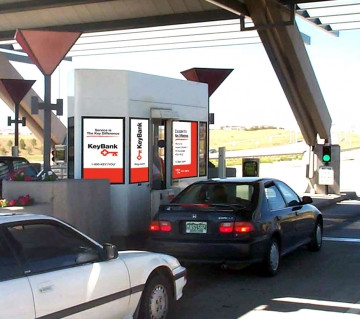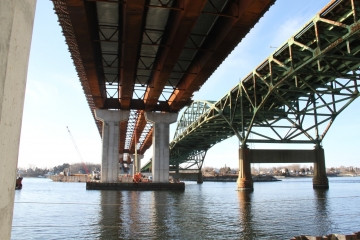Bishop: For Whom the Bill Tolls
Thursday, November 12, 2015
That, of course, is the worry that a majority of the state’s engaged citizens express with regards to massive borrowing the Governor has proposed to fund with tolls. But, so inevitable is the sense that we are about to hand a billion dollars to the DOT and its bondholders that even the most determined critics are focused only on alternatives of where to get the money.
Echoing Nancy Pelosi’s infamous exhortation about Obamacare, that Congress has to pass the bill so you can see what is in it, the Raimondo administration has doubled down on a lack of transparency over its plan. But unlike Obamacare, we’re not dealing with a plan that is too long and complex to read and analyze before voting, but one that is too short and vague for anyone to know what they are actually voting on.
Perhaps the only thing that the Raimondo administration has been clear about is that her plan will start by targeting trucks. What trucks is a moving target; what bridges is a moving target; how much the tolls will be is a moving target. The electorate, to its credit, resists the siren song not to worry about the details because someone else will pay the cost. Instead widespread public critique of this gambit has adopted an economic paraphrase of Martin Neimoller’s criticism of the ruthless Nazi divide and conquer strategy: “first they came for the trucks”.
GET THE LATEST BREAKING NEWS HERE -- SIGN UP FOR GOLOCAL FREE DAILY EBLASTWhere Tolls Work
The irony is that tolls, made noticeably more efficient with automated collection infrastructure, have proven to be an appropriate source of revenue for capacity expansion and congestion mitigation in other states.
But here, we have no bold plan to build the connecting highway to URI and the Jamestown Bridge from 95, enhancing capacity for reaching the state’s educational and tourism centers. Here we have no bold plan to add lanes to 95 to provide rush hour relief. Here we have no bold plan to add interface between Route 4 and Route 95 South to enhance Quonset as a hub for shipping along the 95 corridor all the way to the Hudson, which would improve Rhode Island’s economy while alleviating regional congestion around New York City from shipments that now must come from New Jersey through the most crowded roads in the northeast. Rather we have a shameless pass the buck approach that says we forgot to fix the bridges so we’ll attempt to graft the money from the least politically powerful constituency.
Spending More, Getting Less
If one is concerned about the political opportunism and lack of transparency in the would be tolling program, what is far worse are the same attributes of the pogram the Governor appears to be carrying out at DOT. The effective sacking of 3 senior officials might indeed be justified in a department that spends more than other states for inferior results. But the Governor has failed to detail what offenses against efficient and effective operation these engineers have committed. With the state being asked to entrust this department with a billion dollars in new spending over the next 30 years, how are taxpayers to understand whether the sidelined officials are part of the problem or the solution?
Rhode Island spends twice the national average per lane mile on its state administered roads. It can be expected that Rhode Island’s costs would be somewhat more because our roads are more heavily traveled and the maintenance of traffic flow during constructions projects adds expense when making otherwise equivalent repairs. But, even controlling for that factor, Rhode Island usually spends more than average and we have some of the poorest bridge infrastructure to show for it.
Unfortunately, it appears that the only transportation statistic the Governor is paying attention to is our high percentage of deficient bridges and not those that question the effectiveness of our spending. If the Governor won’t take this issue seriously, it falls to the legislature to examine whether this history of inefficiency arises because of the relatively small size of the Rhode Island road construction market; explicit or implicit barriers to entry for contractors; cozy relations between our cadre of contractors and the department; poor bid segmenting; failure to monitor specs or secure long term performance; higher prevailing wage than other jurisdictions; etc.
And while efficiency is open to question, so is the decision making at DOT that apparently hasn’t been prioritizing failing infrastructure. Instead we spent $44 million on a useless train station in Wickford and millions to maintain it while bridges are crumbling. We spent $25 million on a bridge for bicycles when it’s the ones for cars that are at risk and we already had lanes on a state administered bridge that serves bicycles for the same crossing. Those two boondoogles would have paid almost 15% of what the Governor wants to borrow right there!
The people of Rhode Island deserve this inquiry and evidence of change before another billion dollars is poorly spent. If these matters are understood and addressed in ways that gain the trust of electorate, this opens a broader range of solutions to funding deficient infrastructure.
First they Came for the Trucks
The Governor has suggested that this burden should fall on trucks because they cause more wear, but has never discussed the increased funds that have already been derived from trucks for years without fixing the bridges. She has never articulated why we should be the only state in the nation that tolls trucks and not cars – raising disappointment from truckers and cynicism from the citizenry who can’t imagine such a wasteful investment of 10s of millions in the gantries without a plan to ultimately use them to toll cars. Perhaps that is just a conspiracy theory since the evidence is that the state makes wasteful investments all the time, but essentially we’re damned either way.
Nor has the Governor responded in a meaningful way to truckers’ alternative proposals for fuel tax and truck registration increases that they see as less complicated and less burdensome. Of course part of the truckers proposition, e.g., a 12¢ increase in the diesel fuel tax, puts more of the cost back on smaller instate trucks. Their proposal is not a holy grail but a constructive contribution that the Governor has ignored.
Pay/Go Alternatives
The governor has equally turned a blind eye to the Center for Freedom and Prosperity’s research into pay/go public private partnerships with long term performance standards. This is not a panacea, as it could effectively shift borrowing costs to the private sector that then simply recoups them in bid pricing. But it is one of few models that checks overrun costs and essentially secures a long term warranty over sections of the state’s infrastructure. These potentially attractive features nonetheless could run afoul of provisions that prevent contracting for governmental functions for terms longer than the serving administration. And this kind of plan is not necessarily indicative of where the money would be drawn from to pay for such contracts if they exceed available transportation funds.
Nor has the Governor responded to the Republican pay/go plan to fund bridge repairs by looking to cuts in the rest of the state budget. Regardless of whether one agrees that the entire amount can be found, these efforts are critical as the highway statistics reveal another built in deficit in Rhode Island’s transportation planning: a reliance on a much higher percentage of federal funding than most other states.
This is a trend that is evolved significantly during the tenure of Senator John Chafee who was chairman of the US Senate Committee responsible for the allocation of transportation funds in the budget. Perhaps the small relative size of Rhode Island’s road infrastructure has served to make it less important for later generations of politicians to walk back this ‘Chafee’ effect, but it no longer escapes the notice of the federal DOT and inevitably a higher percentage of state funds must be devoted to roads which means we will have to cut spending in other areas.
Costs of Borrowing
Meanwhile, the Governor has argued that borrowing for this bridge work is defensible as availability of more money earlier in the program will prevent the same job from having to be done twice, i.e. once as temporary repairs and second as permanent repairs. Certainly, this is not to be dismissed out of hand, anymore than the simple economic argument that if the pace of construction inflation – even of efficient construction – is higher than the interest rate, some borrowing can be appropriate.
But the cost benefit equation would look better at a lower interest rate, which could be obtained if the Governor works to enlist the citizenry for her plan instead of enact it in spite of them. Then necessary borrowing for a popular plan could be put before the electorate in a referendum.
Merits of roadwork as economic ‘stimulus’
But whatever we spend on the roads, the Governor argues, stimulates the economy. The Governor’s studies are wrong on this. Any benefit derived from money circulated in the economy to road workers is offset because the money is taken from trucking companies and consumers who have less money to spend in the economy. But strategic spending for a better higher capacity road system is essential to economic development in a nation whose culture of individual mobility is linked hand in hand with its vocational and recreational opportunities.
The wrong road on tolls
Governor Raimondo is following in the footsteps of Governor Chafee who poisoned the well for any appropriate uses of tolls to build needed new infrastructure and manage efficient allocation of that we have already built by pushing blithely for tolls on the Sakonnet River Bridge and refusing all talk of other alternatives (until he had no alternative).
Lets not turn our roads into the next 38 Studios where taxpayers will indeed be on the hook if tolls can’t cover borrowing (just as Gina Raimondo herself told us we were on the hook for 38 Studios revenue bonds because of the state’s reputation). To endorse Rhode Works, Citizens must see improved performance from DOT, and significant changes the reflect fair vetting of funding sources and capital spending imperatives for highways. In the end they must have a say at referendum on any borrowing.
The Governor must engage a broad process that honestly builds an alternative that is not simply ‘my way for the highways’. If, instead, she pushes this flawed tolling uber alles program, any legislator who votes for it must get a serious challenger – whether in the primary or general election. This isn’t an effort to promote partisan advantage but a recommendation that citizens take effective aim at politicians who don’t respect their right to vote when state debt is engaged.
Brian Bishop is on the board of OSTPA and has spent 20 years of activism protecting property rights, fighting overregulation and perverse incentives in tax policy.
Related Slideshow: 10 Biggest Questions Facing Truck Tolls in RI
Related Articles
- Pam Gencarella: Is the Pendulum Swinging Back Toward the Center?
- Pam Gencarella: Don’t Touch That Dial
- Pam Gencarella: Context Is What’s Needed - Part I
- Gencarella: RI Stands Apart From a World Where Change Is the Only Constant
- Pam Gencarella: Surprised, Bewildered, Shocked, Disappointed
- Pam Gencarella: It’s Easy to Vote for Santa
- Pam Gencarella: Why You Should Care About a Constitutional Convention
- Pam Gencarella: A Civics Lesson From the East Bay
- Pam Gencarella: A Race to the Top or Running in Circles?
- Pam Gencarella: RI Has Lost Cabin Pressure
- Pam Gencarella: Witness the Crowding Out of Public Services
- Pam Gencarella: What’s All the Fuss About RhodeMap RI? If You Like Your Municipality, Keep It
- Gencarella: What Side Are You On? Do Organizations & Consortium Members Really Support RhodeMap RI?
- Pam Gencarella: The Twilight Zone
- Gencarella: RI Firefighters: Public Servants, Hardly Indentured Servants
- Gencarella: Is RI On A Path To Socialized HealthCare?
- Gencarella: Rhode Island - The Rule of Lawlessness
- Gencarella: It’s Time to Brew Our Own Coffee and Cut Out the Coolattas
- Gencarella: Let’s Leave It A Local Issue
- Gencarella: A Drop In The Proverbial Ocean State Budget
- Gencarella: Are Local Governments Kidding Themselves?
- Pam Gencarella: Where Does Raimondo’s Vision Put Us in Five Years?
- Gencarella: Can We “Make it in RI?”
- Gencarella: Public Union Benefits Limit What Our Government Can Do For Taxpayers.
- Gencarella: Is There a Movement Afoot


























